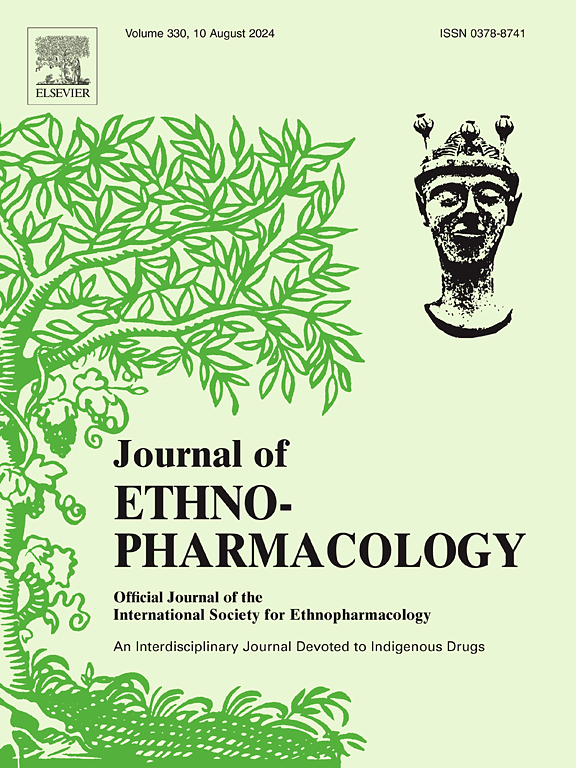纤毛草提取物对Poly I: c处理RAW264.7细胞的抗炎作用
IF 4.8
2区 医学
Q1 CHEMISTRY, MEDICINAL
引用次数: 0
摘要
炎症是对有害刺激的重要生物反应,包括物理损伤和致病性感染,涉及免疫细胞和各种炎症介质,限制细胞损伤和消除病原体。虽然炎症对愈合至关重要,但也会引起发烧、肿胀、疼痛和瘙痒等症状,可能会降低生活质量。传统医学中使用的纤毛草具有抗病毒、抗菌、解热、发汗、驱风、收敛、利尿等多种药用特性。本研究旨在评价纤毛提取物(ECE)对多肌苷多胞酸(Poly I:C)处理RAW264.7细胞的抗炎作用。材料与方法采用ELISA和/或real-time PCR检测spge2、IL-1β、TNF-α、IFN-β和IL-6水平。采用western blotting和real-time PCR分析COX-2和iNOS的表达。western blotting分析AKT、IRF3、TBK1、STAT1、MAPKs、i - κ b、i - κ k等信号蛋白的磷酸化和表达水平。采用高效液相色谱-质谱联用(HPLC-MS)法测定其活性物质。结果我们的检测显示,ECE抑制一氧化氮和中枢炎症介质(如iNOS和COX-2)的水平。此外,ECE下调促炎细胞因子的表达,包括PGE2、IL-1β、TNF-α、IFN-β和IL-6。此外,ECE抑制Poly I: c处理RAW264.7细胞中AKT、TBK1/IRF3、MAPK和NF-κB等多种细胞信号通路的磷酸化。结论这些结果突出了纤毛杆菌作为缓解病毒诱导炎症的候选药物,为其在开发新的抗炎药物方面的应用提供了有价值的见解。本文章由计算机程序翻译,如有差异,请以英文原文为准。
Anti-inflammatory effects of Elsholtzia ciliata extract on Poly I:C-treated RAW264.7 cells
Ethnopharmacological relevance
Inflammation is a vital biological response to noxious stimuli, including physical injury and pathogenic infection, and involves immune cells and various inflammatory mediators, limiting cell damage and eliminating pathogens. Although essential for healing, inflammation can cause symptoms, such as fever, swelling, pain, and itching, potentially reducing quality of life. Elsholtzia ciliata used in traditional medicine has numerous medicinal characteristics such as antiviral, antibacterial, antipyretic, diaphoretic, carminative, astringent, and diuretic effects.
Aim of the study
This study aimed to evaluate the anti-inflammatory properties of E. ciliata extract (ECE) in RAW264.7 cells treated with polyinosinic polycytidylic acid (Poly I:C).
Materials and methods
PGE2, IL-1β, TNF-α, IFN-β, and IL-6 levels were quantified by ELISA and/or real-time PCR. COX-2 and iNOS expression was analyzed using western blotting and real-time PCR. Phosphorylation and expression levels of signaling proteins, including AKT, IRF3, TBK1, STAT1, MAPKs, IκB, and IκK were analyzed using western blotting. The active substance of ECE was determined using high-performance liquid chromatography-mass spectrometry (HPLC-MS).
Results
Our detections revealed that ECE inhibited the levels of nitric oxide and central inflammatory mediators, such as iNOS and COX-2. Furthermore, ECE downregulated the expression of pro-inflammatory cytokines, including PGE2, IL-1β, TNF-α, IFN-β, and IL-6. Additionally, ECE inhibited the phosphorylation of several cell signaling pathways, including AKT, TBK1/IRF3, MAPK, and NF-κB, in Poly I:C-treated RAW264.7 cells.
Conclusions
These results highlight E. ciliata as a candidate for mitigating virus-induced inflammation, providing valuable insights into its use in the development of new anti-inflammatory therapeutics.
求助全文
通过发布文献求助,成功后即可免费获取论文全文。
去求助
来源期刊

Journal of ethnopharmacology
医学-全科医学与补充医学
CiteScore
10.30
自引率
5.60%
发文量
967
审稿时长
77 days
期刊介绍:
The Journal of Ethnopharmacology is dedicated to the exchange of information and understandings about people''s use of plants, fungi, animals, microorganisms and minerals and their biological and pharmacological effects based on the principles established through international conventions. Early people confronted with illness and disease, discovered a wealth of useful therapeutic agents in the plant and animal kingdoms. The empirical knowledge of these medicinal substances and their toxic potential was passed on by oral tradition and sometimes recorded in herbals and other texts on materia medica. Many valuable drugs of today (e.g., atropine, ephedrine, tubocurarine, digoxin, reserpine) came into use through the study of indigenous remedies. Chemists continue to use plant-derived drugs (e.g., morphine, taxol, physostigmine, quinidine, emetine) as prototypes in their attempts to develop more effective and less toxic medicinals.
 求助内容:
求助内容: 应助结果提醒方式:
应助结果提醒方式:


